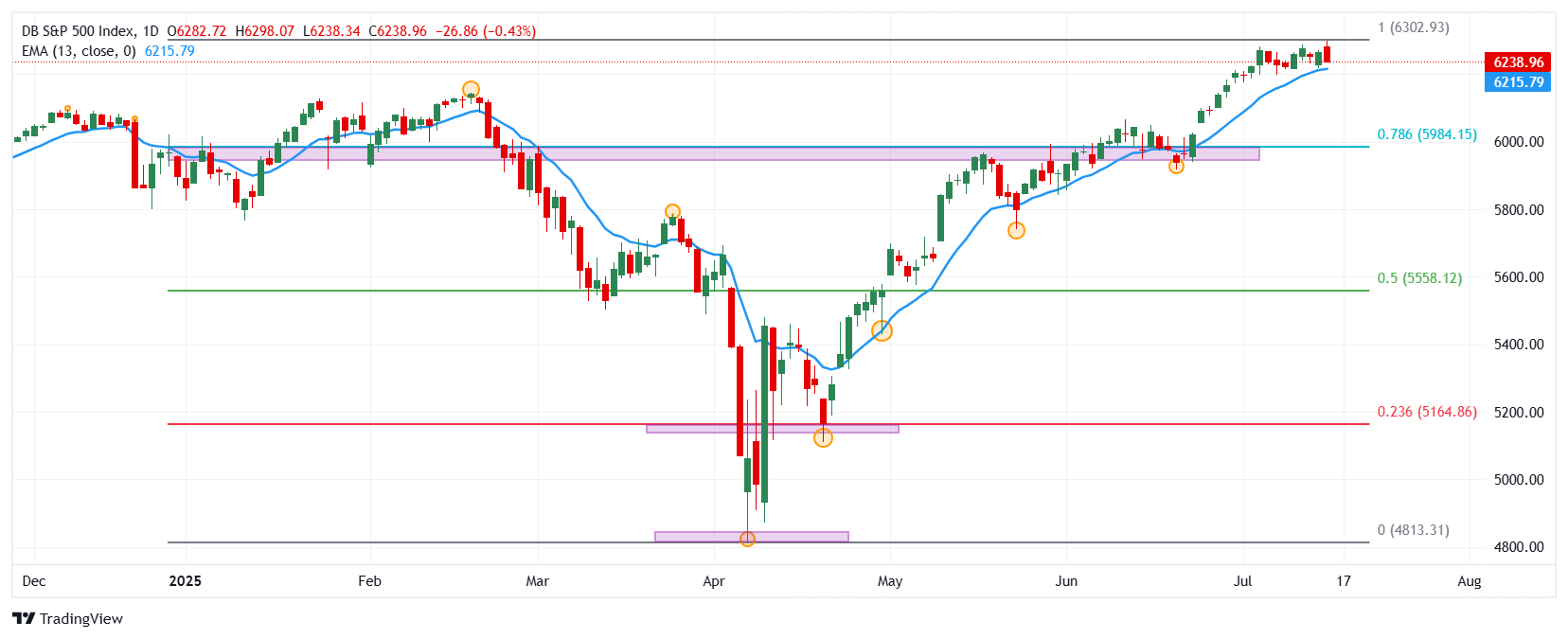- The S&P 500 stock index falls 0.43% daily after registering new historical maximums in 6,298.
- State Street Corporation Titles (STT) lose 7.29% daily, reaching June 25 at 101.98 $.
- Agilent Technologies values (a) decrease 5.95% today, reaching minimum of June 3 in 111.93 $.
- The US consumption price index rose 2.7% year -on -year in June, fulfilling market estimates.
The S&P 500 reacted the decline from a new historical maximum located in 6,298, where it attracted aggressive vendors that led the index to a daily minimum in 6,238. At the time of writing, the S&P 500 operates over 6,238, losing 0.43% on the second day of the week.
The S&P 500 slides in the medium of the United States key data
Based on information provided by the US Labor Statistics Office, the consumption price index increased by 2.7% year -on -year in June, in line with analysts projections. This figure is slightly above 2.4% recorded in May.
On the other hand, the president of the Boston Federal Reserve, Susan Collins, said that tariff rhetoric will increase inflation and reduce hiring. In addition, he added that it is a challenge to establish monetary policy in the midst of commercial uncertainty.
State Street Corporation (STT) shares collapse 7.29% today, reaching minimum of June 25 in 101.98. In the same harmony, the values of Agilent Technologies (a) fall 5.95% daily, reaching minimum of June 3 in 111.93 $.
The United States economic calendar includes the United States Production Price Index (IPP) tomorrow, it is expected to be 2.5%, slightly below the 2.6% observed the previous month.
In this context, the S&P 500 falls 26 points, concluding Tuesday at 6,238.
Levels to be considered in the S&P 500
The S&P 500 reacted the decline from a short -term resistance given by the historical maximum reached today in 6,298. Downwards, the closest support is in 5,917 minimum of June 19 in convergence with the recoil at 78.6% of Fibonacci. We observe the following key support in 5.430, Pivot Point of April 30.
S&P 500 DAILY GRAPH

S&P 500 – Frequently Questions
The S&P 500 is a very often stock index that measures the yield of 500 public companies and is considered a wide measure of the US stock market. The influence of each company on the calculation of the index is weighted based on stock capitalization. This is calculated by multiplying the number of bought shares of the company for the price of the action. The S&P 500 index has achieved impressive yields: 1.00 $ invested in 1970 would have produced a yield of almost $ 192.00 in 2022. The average annual profitability since its creation in 1957 has been 11.9%.
Companies are selected by Committee, unlike other indices that are included based on established standards. Even so, they must fulfill certain eligibility criteria, the most important of which is stock market, which must be equal to or greater than 12.7 billion dollars. Other criteria are liquidity, domicile, stock capitalization, sector, financial viability, quotation time and representation of the sectors of the United States economy. The nine largest companies in the index represent 27.8% of the stock market capitalization.
There are several ways to operate with the S&P 500. Most of the Stred Betting retail runners and platforms allow operators to use contracts per difference (CFD) to make bets on the price direction. In addition, indexed funds, investment funds and quoted funds (ETF) that follow the price of the S&P 500 can be purchased. The most ETF liquid is the ETF of the London Stock Exchange. The most ETF liquid is the State Street Corporation Spy. The Chicago Mercantile Exchange (CME) offers futures contracts on the index and the Chicago Board of Options (CMOE) offers options, as well as ETF, ETF Inverse and ETF leverage.
There are many factors that promote S&P 500, but mainly it is the aggregate performance of the companies that compose it, revealed in their reports of quarterly and annual results. American and world macroeconomic data also contribute, since they influence investors’ confidence, which is positive drives profits. The level of interest rates, set by the Federal Reserve (FED), also influences the S&P 500, since it affects the cost of credit, which is largely depending on many companies. Therefore, inflation can be a determining factor, as well as other parameters that influence the decisions of the Federal Reserve.
Source: Fx Street
I am Joshua Winder, a senior-level journalist and editor at World Stock Market. I specialize in covering news related to the stock market and economic trends. With more than 8 years of experience in this field, I have become an expert in financial reporting.







